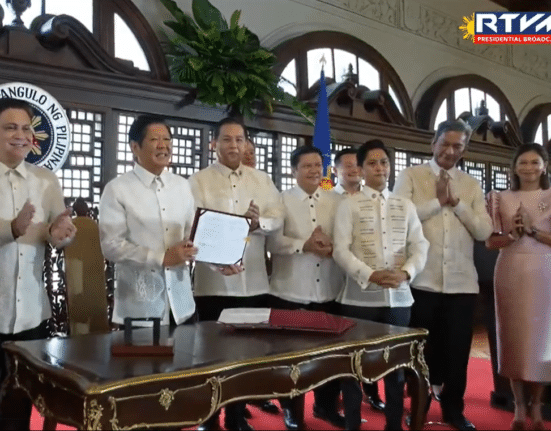President Ferdinand Marcos Jr. signed the Maharlika Investment Fund (MIF) Law at a ceremony in Malacañang on Tuesday following months of debate on the measure.
Marcos signed Republic Act 11954 despite opposition from some quarters, which questioned the necessity of a sovereign wealth fund in light of the government’s budget deficit and expressed concerns about the possibility of corruption.
The MIF aims to execute and sustain high-impact infrastructure and development projects, ease fiscal constraints, and maximize expected returns for the country’s investments, according to the Marcos administration’s economic managers.
They said that safeguards have been put in place based on the version passed by Congress, such as the formation of a risk management committee to make sure that adequate steps are taken to achieve a prudent balance between risk and reward in both continuing and new business activity, as well as congressional oversight.
It also bars government-owned and controlled corporations that provide social security and health benefits from investing in the Maharlika Investment Corporation.
These include the Social Security System, the Government Service Insurance System, the Philippine Health Insurance Corporation, the Overseas Workers Welfare Administration, the Philippine Veterans Affairs Office, and the Home Development Mutual Fund (Pag-IBIG Fund).
Aside from being subjected to special audits from the Commission on Audit, the MIF will also be overseen by an Internal Auditor and an External Auditor.
All documents of the MIF and MIC, including investments and audit reports from the COA must be accessible to the public.
Officers who engage in illegal activity, hide corruption, or support it may face heavy fines and punishments, including lifetime bans from holding public office.
”I assure you that the fund will be managed by highly competent personnel with a good track record and outstanding integrity,” Marcos said in his speech during the signing ceremony.
”We remain steadfast in our commitment to transparency, accountability, and good governance in this massive and purposeful undertaking,” he added.
Marcos assured the public that the funds would be ”taken care of with utmost prudence and integrity.”
”I note that some of the objections very early on, I would hear some people commenting and saying, ‘Hindi ba kung may pera tayong ganyan, kung may pondo tayong ganyan dapat ilagay ‘yan sa agrikultura, dapat ilagay ‘yan sa infrastructure, dapat ilagay ‘yan sa energy development,”’ he said.
”Nanunuod ako ng television, sabi ko sa kanila, siyempre kinakausap ko ‘yung TV: ‘Saan niyo kaya iniisip na ilalagay ‘yan? Bibili kami ng mga magagarang kotse? Bibili kami ng malalaking yate? ‘Yan ba ‘yung iniisip ninyo?’ It makes me laugh because that is so far from the truth.”
In Mendiola, Manila, which is near the presidential palace, students and youth groups held a protest to oppose the enactment of the MIF bill.

Funding sources
The MIF will have a P500 billion authorized capital stock, P125 billion of which will initially come from investible funds of specific government financial institutions (Landbank of the Philippines: P50 billion; Development Bank of the Philippines: P25 billion), and the remaining P50 billion will come from contributions from the national government.
The fund will be managed by the MIC, which has a nine-member board chaired by the Secretary of Finance.
The other members of the MIC Board are the MIC president and CEO, the heads of Landbank and the DBP, two regular directors, and three independent directors from the private sector.
The allowable investments are cash, foreign currencies, metals, and other tradeable commodities; joint ventures or co-investments; mergers and acquisitions; real estate and infrastructure projects; programs and projects on health, education, research, and innovation; and other such investments that contribute to sustainable development, among others.
”For the first time in the history of the Philippines, we now have a sovereign wealth fund designed to drive economic development,” Marcos said.
”Through the Fund, we will leverage on a small fraction of the considerable but underutilized investable funds of government and stimulate the economy without the disadvantage of having additional fiscal and debt burden,” he added.
The Maharlika measure’s constitutionality can be challenged before the Supreme Court.









